ACCT20074 - Classical Political Economy: JB Hi-Fi's Profit Downgrade
VerifiedAdded on 2023/06/11
|14
|4113
|432
Report
AI Summary
This report analyzes JB Hi-Fi's decision to release its profit downgrade announcement through the lens of Classical Political Economy and Institutional Theory. It examines the factors contributing to the downgrade, including declining sales growth in The Good Guys business segment and increased price competition. The report also discusses Managerial branch of stakeholder theory and how it attempts to illustrate the time when corporate management are more probable to meet specific expectations of influential stakeholders. Furthermore, it explores the relationship between a company's earnings and stock price, emphasizing the importance of earnings per share (EPS) and the price-to-earnings (P/E) ratio. The analysis incorporates evidence from the case study and relevant academic literature to provide a comprehensive understanding of JB Hi-Fi's strategic decisions in the context of its operating environment.
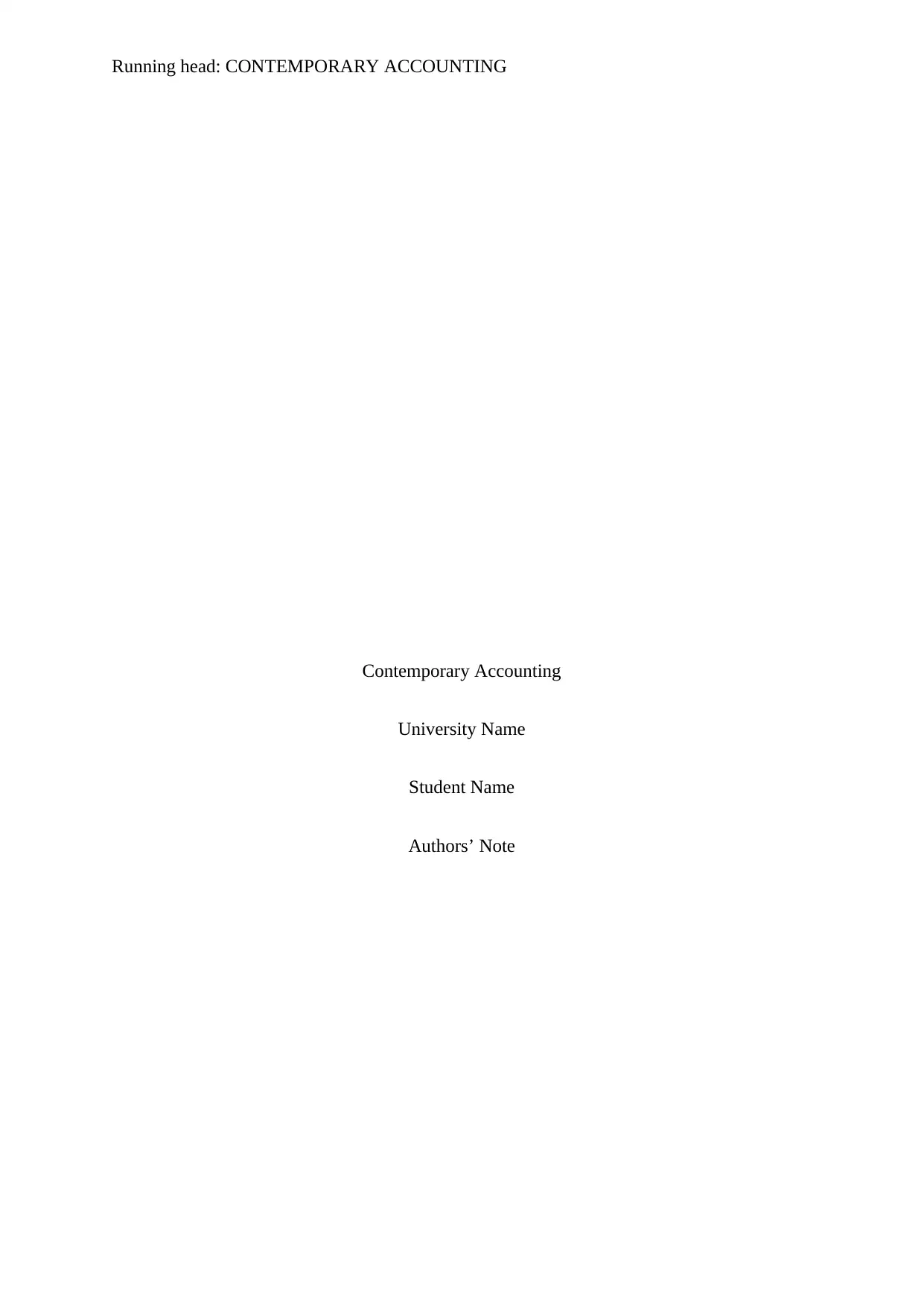
Running head: CONTEMPORARY ACCOUNTING
Contemporary Accounting
University Name
Student Name
Authors’ Note
Contemporary Accounting
University Name
Student Name
Authors’ Note
Paraphrase This Document
Need a fresh take? Get an instant paraphrase of this document with our AI Paraphraser
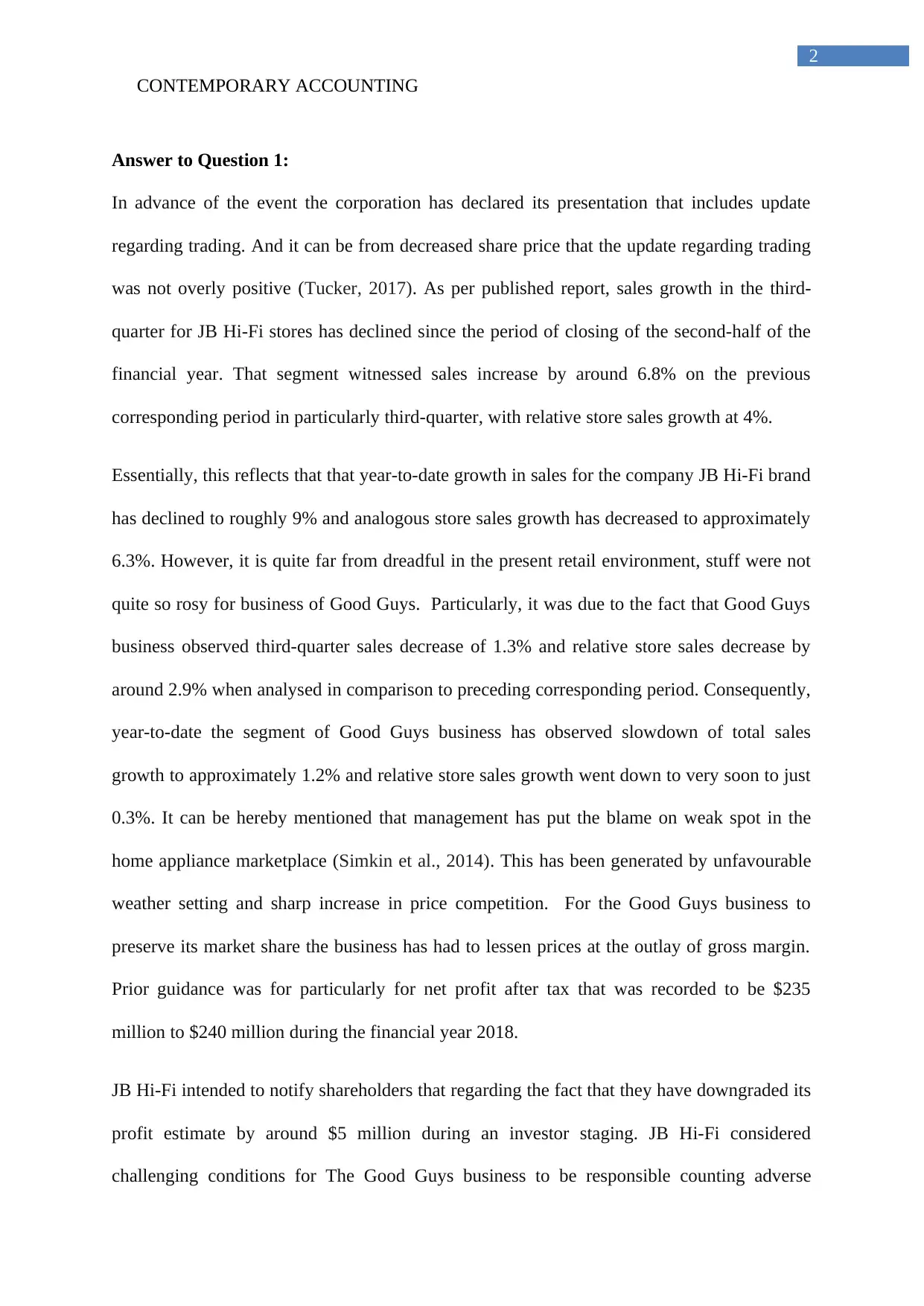
2
CONTEMPORARY ACCOUNTING
Answer to Question 1:
In advance of the event the corporation has declared its presentation that includes update
regarding trading. And it can be from decreased share price that the update regarding trading
was not overly positive (Tucker, 2017). As per published report, sales growth in the third-
quarter for JB Hi-Fi stores has declined since the period of closing of the second-half of the
financial year. That segment witnessed sales increase by around 6.8% on the previous
corresponding period in particularly third-quarter, with relative store sales growth at 4%.
Essentially, this reflects that that year-to-date growth in sales for the company JB Hi-Fi brand
has declined to roughly 9% and analogous store sales growth has decreased to approximately
6.3%. However, it is quite far from dreadful in the present retail environment, stuff were not
quite so rosy for business of Good Guys. Particularly, it was due to the fact that Good Guys
business observed third-quarter sales decrease of 1.3% and relative store sales decrease by
around 2.9% when analysed in comparison to preceding corresponding period. Consequently,
year-to-date the segment of Good Guys business has observed slowdown of total sales
growth to approximately 1.2% and relative store sales growth went down to very soon to just
0.3%. It can be hereby mentioned that management has put the blame on weak spot in the
home appliance marketplace (Simkin et al., 2014). This has been generated by unfavourable
weather setting and sharp increase in price competition. For the Good Guys business to
preserve its market share the business has had to lessen prices at the outlay of gross margin.
Prior guidance was for particularly for net profit after tax that was recorded to be $235
million to $240 million during the financial year 2018.
JB Hi-Fi intended to notify shareholders that regarding the fact that they have downgraded its
profit estimate by around $5 million during an investor staging. JB Hi-Fi considered
challenging conditions for The Good Guys business to be responsible counting adverse
CONTEMPORARY ACCOUNTING
Answer to Question 1:
In advance of the event the corporation has declared its presentation that includes update
regarding trading. And it can be from decreased share price that the update regarding trading
was not overly positive (Tucker, 2017). As per published report, sales growth in the third-
quarter for JB Hi-Fi stores has declined since the period of closing of the second-half of the
financial year. That segment witnessed sales increase by around 6.8% on the previous
corresponding period in particularly third-quarter, with relative store sales growth at 4%.
Essentially, this reflects that that year-to-date growth in sales for the company JB Hi-Fi brand
has declined to roughly 9% and analogous store sales growth has decreased to approximately
6.3%. However, it is quite far from dreadful in the present retail environment, stuff were not
quite so rosy for business of Good Guys. Particularly, it was due to the fact that Good Guys
business observed third-quarter sales decrease of 1.3% and relative store sales decrease by
around 2.9% when analysed in comparison to preceding corresponding period. Consequently,
year-to-date the segment of Good Guys business has observed slowdown of total sales
growth to approximately 1.2% and relative store sales growth went down to very soon to just
0.3%. It can be hereby mentioned that management has put the blame on weak spot in the
home appliance marketplace (Simkin et al., 2014). This has been generated by unfavourable
weather setting and sharp increase in price competition. For the Good Guys business to
preserve its market share the business has had to lessen prices at the outlay of gross margin.
Prior guidance was for particularly for net profit after tax that was recorded to be $235
million to $240 million during the financial year 2018.
JB Hi-Fi intended to notify shareholders that regarding the fact that they have downgraded its
profit estimate by around $5 million during an investor staging. JB Hi-Fi considered
challenging conditions for The Good Guys business to be responsible counting adverse
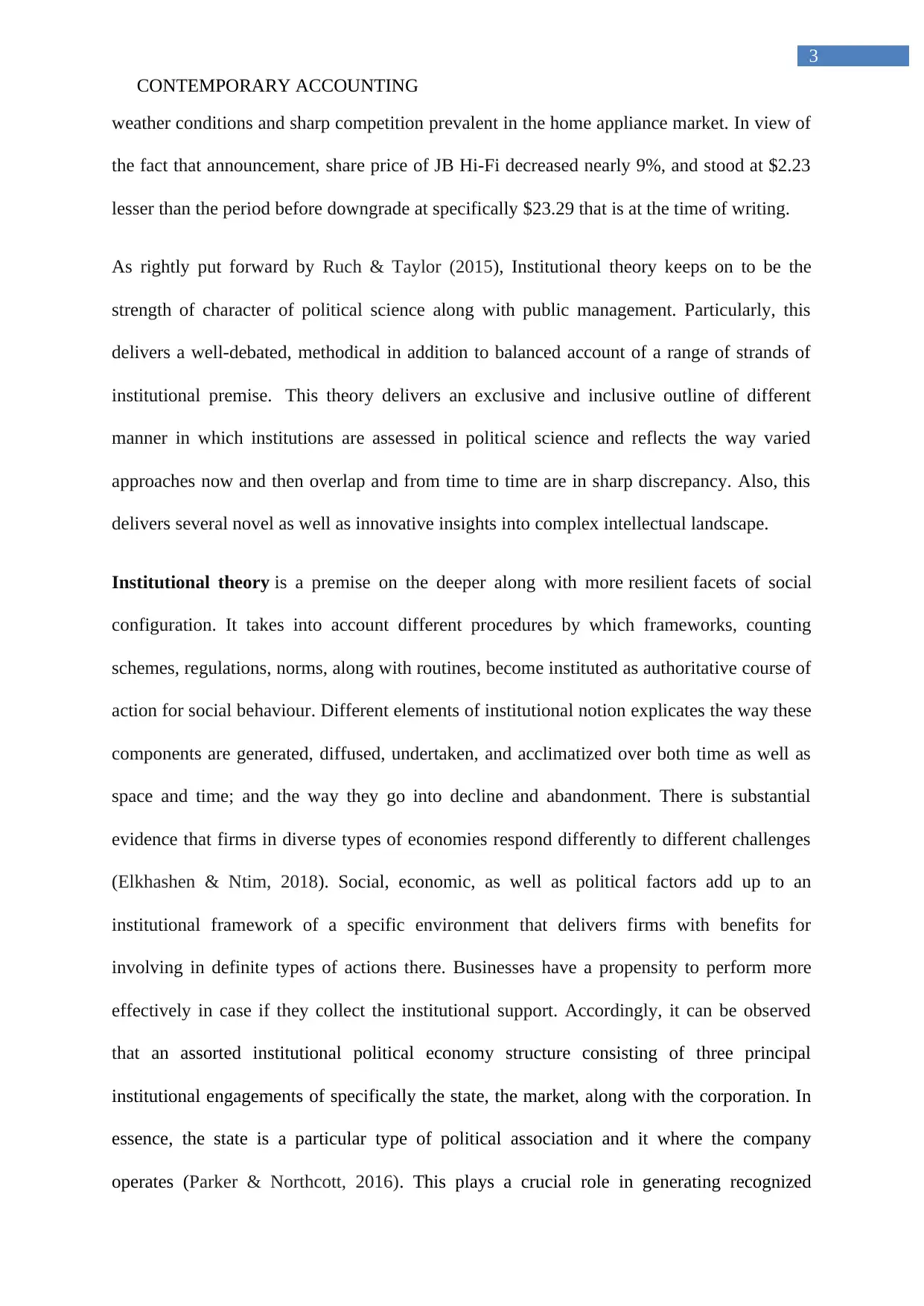
3
CONTEMPORARY ACCOUNTING
weather conditions and sharp competition prevalent in the home appliance market. In view of
the fact that announcement, share price of JB Hi-Fi decreased nearly 9%, and stood at $2.23
lesser than the period before downgrade at specifically $23.29 that is at the time of writing.
As rightly put forward by Ruch & Taylor (2015), Institutional theory keeps on to be the
strength of character of political science along with public management. Particularly, this
delivers a well-debated, methodical in addition to balanced account of a range of strands of
institutional premise. This theory delivers an exclusive and inclusive outline of different
manner in which institutions are assessed in political science and reflects the way varied
approaches now and then overlap and from time to time are in sharp discrepancy. Also, this
delivers several novel as well as innovative insights into complex intellectual landscape.
Institutional theory is a premise on the deeper along with more resilient facets of social
configuration. It takes into account different procedures by which frameworks, counting
schemes, regulations, norms, along with routines, become instituted as authoritative course of
action for social behaviour. Different elements of institutional notion explicates the way these
components are generated, diffused, undertaken, and acclimatized over both time as well as
space and time; and the way they go into decline and abandonment. There is substantial
evidence that firms in diverse types of economies respond differently to different challenges
(Elkhashen & Ntim, 2018). Social, economic, as well as political factors add up to an
institutional framework of a specific environment that delivers firms with benefits for
involving in definite types of actions there. Businesses have a propensity to perform more
effectively in case if they collect the institutional support. Accordingly, it can be observed
that an assorted institutional political economy structure consisting of three principal
institutional engagements of specifically the state, the market, along with the corporation. In
essence, the state is a particular type of political association and it where the company
operates (Parker & Northcott, 2016). This plays a crucial role in generating recognized
CONTEMPORARY ACCOUNTING
weather conditions and sharp competition prevalent in the home appliance market. In view of
the fact that announcement, share price of JB Hi-Fi decreased nearly 9%, and stood at $2.23
lesser than the period before downgrade at specifically $23.29 that is at the time of writing.
As rightly put forward by Ruch & Taylor (2015), Institutional theory keeps on to be the
strength of character of political science along with public management. Particularly, this
delivers a well-debated, methodical in addition to balanced account of a range of strands of
institutional premise. This theory delivers an exclusive and inclusive outline of different
manner in which institutions are assessed in political science and reflects the way varied
approaches now and then overlap and from time to time are in sharp discrepancy. Also, this
delivers several novel as well as innovative insights into complex intellectual landscape.
Institutional theory is a premise on the deeper along with more resilient facets of social
configuration. It takes into account different procedures by which frameworks, counting
schemes, regulations, norms, along with routines, become instituted as authoritative course of
action for social behaviour. Different elements of institutional notion explicates the way these
components are generated, diffused, undertaken, and acclimatized over both time as well as
space and time; and the way they go into decline and abandonment. There is substantial
evidence that firms in diverse types of economies respond differently to different challenges
(Elkhashen & Ntim, 2018). Social, economic, as well as political factors add up to an
institutional framework of a specific environment that delivers firms with benefits for
involving in definite types of actions there. Businesses have a propensity to perform more
effectively in case if they collect the institutional support. Accordingly, it can be observed
that an assorted institutional political economy structure consisting of three principal
institutional engagements of specifically the state, the market, along with the corporation. In
essence, the state is a particular type of political association and it where the company
operates (Parker & Northcott, 2016). This plays a crucial role in generating recognized
⊘ This is a preview!⊘
Do you want full access?
Subscribe today to unlock all pages.

Trusted by 1+ million students worldwide
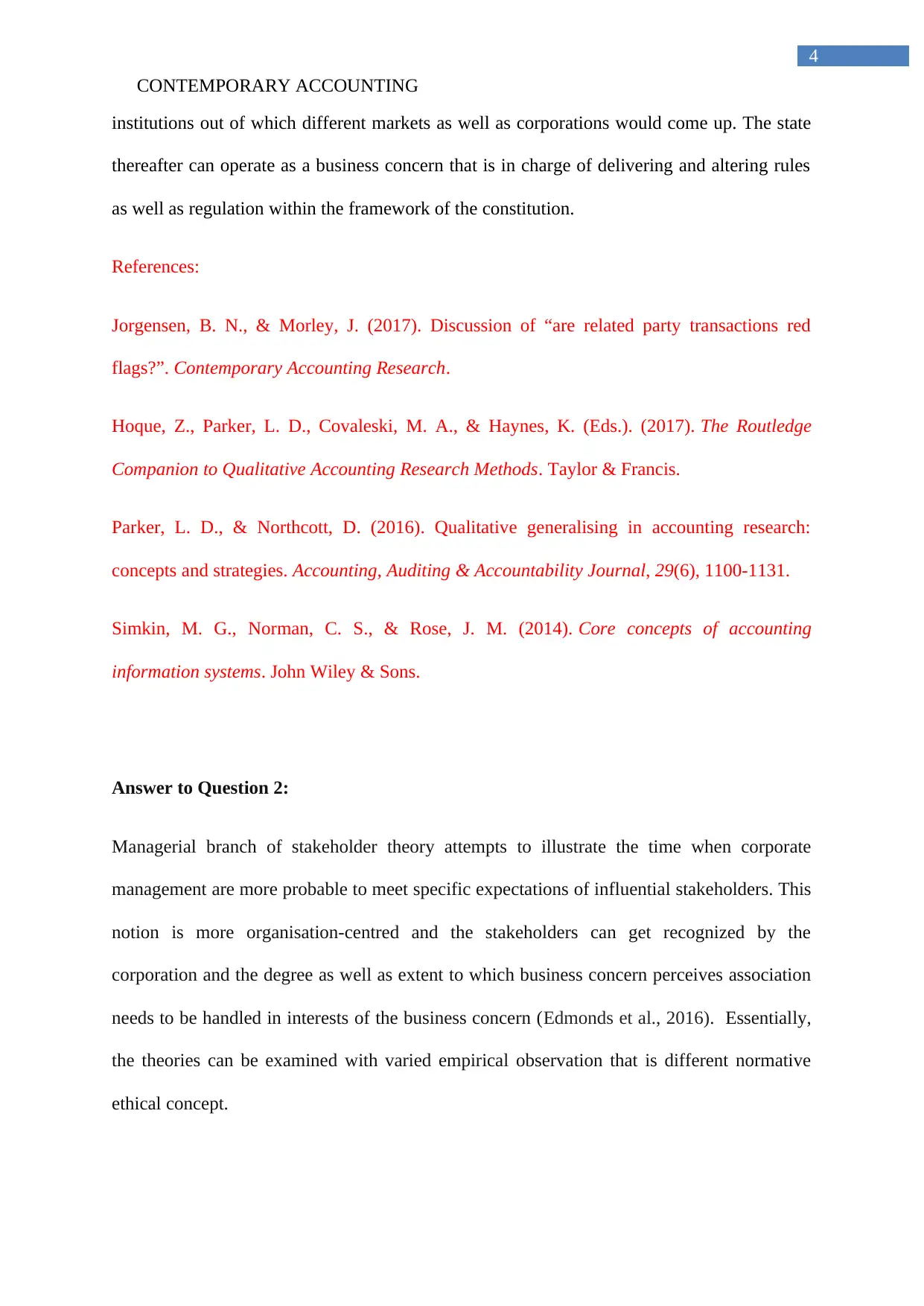
4
CONTEMPORARY ACCOUNTING
institutions out of which different markets as well as corporations would come up. The state
thereafter can operate as a business concern that is in charge of delivering and altering rules
as well as regulation within the framework of the constitution.
References:
Jorgensen, B. N., & Morley, J. (2017). Discussion of “are related party transactions red
flags?”. Contemporary Accounting Research.
Hoque, Z., Parker, L. D., Covaleski, M. A., & Haynes, K. (Eds.). (2017). The Routledge
Companion to Qualitative Accounting Research Methods. Taylor & Francis.
Parker, L. D., & Northcott, D. (2016). Qualitative generalising in accounting research:
concepts and strategies. Accounting, Auditing & Accountability Journal, 29(6), 1100-1131.
Simkin, M. G., Norman, C. S., & Rose, J. M. (2014). Core concepts of accounting
information systems. John Wiley & Sons.
Answer to Question 2:
Managerial branch of stakeholder theory attempts to illustrate the time when corporate
management are more probable to meet specific expectations of influential stakeholders. This
notion is more organisation-centred and the stakeholders can get recognized by the
corporation and the degree as well as extent to which business concern perceives association
needs to be handled in interests of the business concern (Edmonds et al., 2016). Essentially,
the theories can be examined with varied empirical observation that is different normative
ethical concept.
CONTEMPORARY ACCOUNTING
institutions out of which different markets as well as corporations would come up. The state
thereafter can operate as a business concern that is in charge of delivering and altering rules
as well as regulation within the framework of the constitution.
References:
Jorgensen, B. N., & Morley, J. (2017). Discussion of “are related party transactions red
flags?”. Contemporary Accounting Research.
Hoque, Z., Parker, L. D., Covaleski, M. A., & Haynes, K. (Eds.). (2017). The Routledge
Companion to Qualitative Accounting Research Methods. Taylor & Francis.
Parker, L. D., & Northcott, D. (2016). Qualitative generalising in accounting research:
concepts and strategies. Accounting, Auditing & Accountability Journal, 29(6), 1100-1131.
Simkin, M. G., Norman, C. S., & Rose, J. M. (2014). Core concepts of accounting
information systems. John Wiley & Sons.
Answer to Question 2:
Managerial branch of stakeholder theory attempts to illustrate the time when corporate
management are more probable to meet specific expectations of influential stakeholders. This
notion is more organisation-centred and the stakeholders can get recognized by the
corporation and the degree as well as extent to which business concern perceives association
needs to be handled in interests of the business concern (Edmonds et al., 2016). Essentially,
the theories can be examined with varied empirical observation that is different normative
ethical concept.
Paraphrase This Document
Need a fresh take? Get an instant paraphrase of this document with our AI Paraphraser
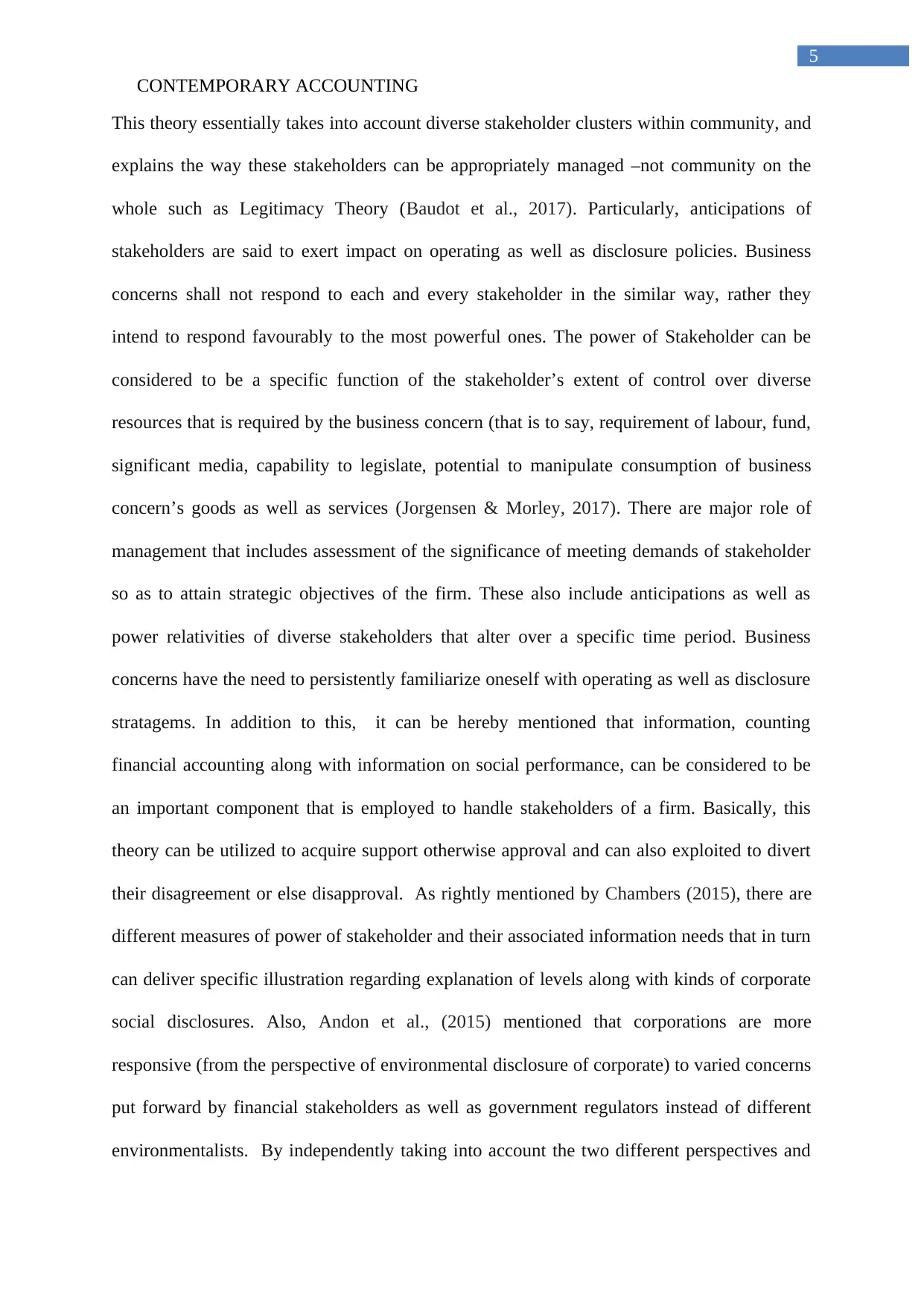
5
CONTEMPORARY ACCOUNTING
This theory essentially takes into account diverse stakeholder clusters within community, and
explains the way these stakeholders can be appropriately managed –not community on the
whole such as Legitimacy Theory (Baudot et al., 2017). Particularly, anticipations of
stakeholders are said to exert impact on operating as well as disclosure policies. Business
concerns shall not respond to each and every stakeholder in the similar way, rather they
intend to respond favourably to the most powerful ones. The power of Stakeholder can be
considered to be a specific function of the stakeholder’s extent of control over diverse
resources that is required by the business concern (that is to say, requirement of labour, fund,
significant media, capability to legislate, potential to manipulate consumption of business
concern’s goods as well as services (Jorgensen & Morley, 2017). There are major role of
management that includes assessment of the significance of meeting demands of stakeholder
so as to attain strategic objectives of the firm. These also include anticipations as well as
power relativities of diverse stakeholders that alter over a specific time period. Business
concerns have the need to persistently familiarize oneself with operating as well as disclosure
stratagems. In addition to this, it can be hereby mentioned that information, counting
financial accounting along with information on social performance, can be considered to be
an important component that is employed to handle stakeholders of a firm. Basically, this
theory can be utilized to acquire support otherwise approval and can also exploited to divert
their disagreement or else disapproval. As rightly mentioned by Chambers (2015), there are
different measures of power of stakeholder and their associated information needs that in turn
can deliver specific illustration regarding explanation of levels along with kinds of corporate
social disclosures. Also, Andon et al., (2015) mentioned that corporations are more
responsive (from the perspective of environmental disclosure of corporate) to varied concerns
put forward by financial stakeholders as well as government regulators instead of different
environmentalists. By independently taking into account the two different perspectives and
CONTEMPORARY ACCOUNTING
This theory essentially takes into account diverse stakeholder clusters within community, and
explains the way these stakeholders can be appropriately managed –not community on the
whole such as Legitimacy Theory (Baudot et al., 2017). Particularly, anticipations of
stakeholders are said to exert impact on operating as well as disclosure policies. Business
concerns shall not respond to each and every stakeholder in the similar way, rather they
intend to respond favourably to the most powerful ones. The power of Stakeholder can be
considered to be a specific function of the stakeholder’s extent of control over diverse
resources that is required by the business concern (that is to say, requirement of labour, fund,
significant media, capability to legislate, potential to manipulate consumption of business
concern’s goods as well as services (Jorgensen & Morley, 2017). There are major role of
management that includes assessment of the significance of meeting demands of stakeholder
so as to attain strategic objectives of the firm. These also include anticipations as well as
power relativities of diverse stakeholders that alter over a specific time period. Business
concerns have the need to persistently familiarize oneself with operating as well as disclosure
stratagems. In addition to this, it can be hereby mentioned that information, counting
financial accounting along with information on social performance, can be considered to be
an important component that is employed to handle stakeholders of a firm. Basically, this
theory can be utilized to acquire support otherwise approval and can also exploited to divert
their disagreement or else disapproval. As rightly mentioned by Chambers (2015), there are
different measures of power of stakeholder and their associated information needs that in turn
can deliver specific illustration regarding explanation of levels along with kinds of corporate
social disclosures. Also, Andon et al., (2015) mentioned that corporations are more
responsive (from the perspective of environmental disclosure of corporate) to varied concerns
put forward by financial stakeholders as well as government regulators instead of different
environmentalists. By independently taking into account the two different perspectives and
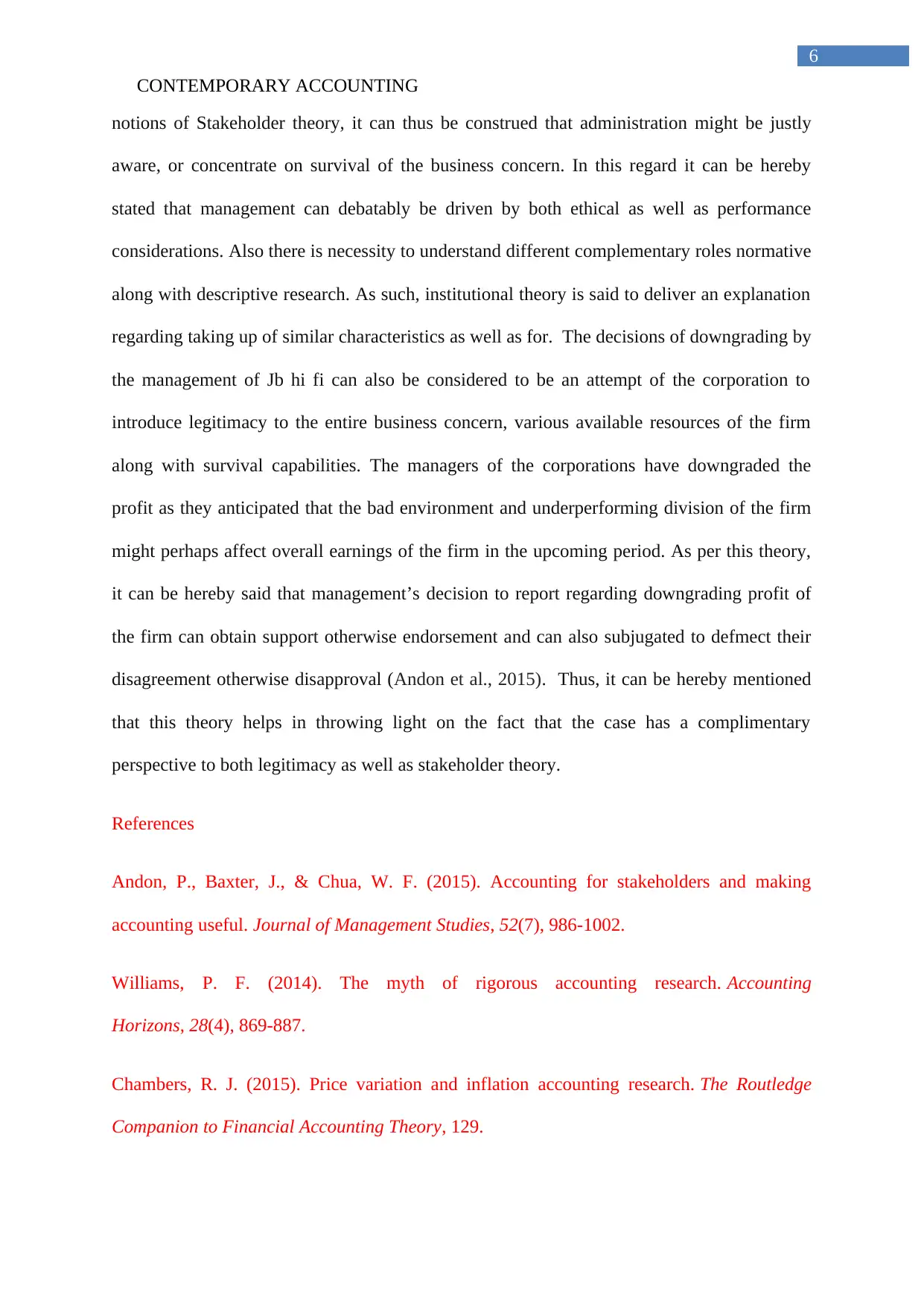
6
CONTEMPORARY ACCOUNTING
notions of Stakeholder theory, it can thus be construed that administration might be justly
aware, or concentrate on survival of the business concern. In this regard it can be hereby
stated that management can debatably be driven by both ethical as well as performance
considerations. Also there is necessity to understand different complementary roles normative
along with descriptive research. As such, institutional theory is said to deliver an explanation
regarding taking up of similar characteristics as well as for. The decisions of downgrading by
the management of Jb hi fi can also be considered to be an attempt of the corporation to
introduce legitimacy to the entire business concern, various available resources of the firm
along with survival capabilities. The managers of the corporations have downgraded the
profit as they anticipated that the bad environment and underperforming division of the firm
might perhaps affect overall earnings of the firm in the upcoming period. As per this theory,
it can be hereby said that management’s decision to report regarding downgrading profit of
the firm can obtain support otherwise endorsement and can also subjugated to defmect their
disagreement otherwise disapproval (Andon et al., 2015). Thus, it can be hereby mentioned
that this theory helps in throwing light on the fact that the case has a complimentary
perspective to both legitimacy as well as stakeholder theory.
References
Andon, P., Baxter, J., & Chua, W. F. (2015). Accounting for stakeholders and making
accounting useful. Journal of Management Studies, 52(7), 986-1002.
Williams, P. F. (2014). The myth of rigorous accounting research. Accounting
Horizons, 28(4), 869-887.
Chambers, R. J. (2015). Price variation and inflation accounting research. The Routledge
Companion to Financial Accounting Theory, 129.
CONTEMPORARY ACCOUNTING
notions of Stakeholder theory, it can thus be construed that administration might be justly
aware, or concentrate on survival of the business concern. In this regard it can be hereby
stated that management can debatably be driven by both ethical as well as performance
considerations. Also there is necessity to understand different complementary roles normative
along with descriptive research. As such, institutional theory is said to deliver an explanation
regarding taking up of similar characteristics as well as for. The decisions of downgrading by
the management of Jb hi fi can also be considered to be an attempt of the corporation to
introduce legitimacy to the entire business concern, various available resources of the firm
along with survival capabilities. The managers of the corporations have downgraded the
profit as they anticipated that the bad environment and underperforming division of the firm
might perhaps affect overall earnings of the firm in the upcoming period. As per this theory,
it can be hereby said that management’s decision to report regarding downgrading profit of
the firm can obtain support otherwise endorsement and can also subjugated to defmect their
disagreement otherwise disapproval (Andon et al., 2015). Thus, it can be hereby mentioned
that this theory helps in throwing light on the fact that the case has a complimentary
perspective to both legitimacy as well as stakeholder theory.
References
Andon, P., Baxter, J., & Chua, W. F. (2015). Accounting for stakeholders and making
accounting useful. Journal of Management Studies, 52(7), 986-1002.
Williams, P. F. (2014). The myth of rigorous accounting research. Accounting
Horizons, 28(4), 869-887.
Chambers, R. J. (2015). Price variation and inflation accounting research. The Routledge
Companion to Financial Accounting Theory, 129.
⊘ This is a preview!⊘
Do you want full access?
Subscribe today to unlock all pages.

Trusted by 1+ million students worldwide
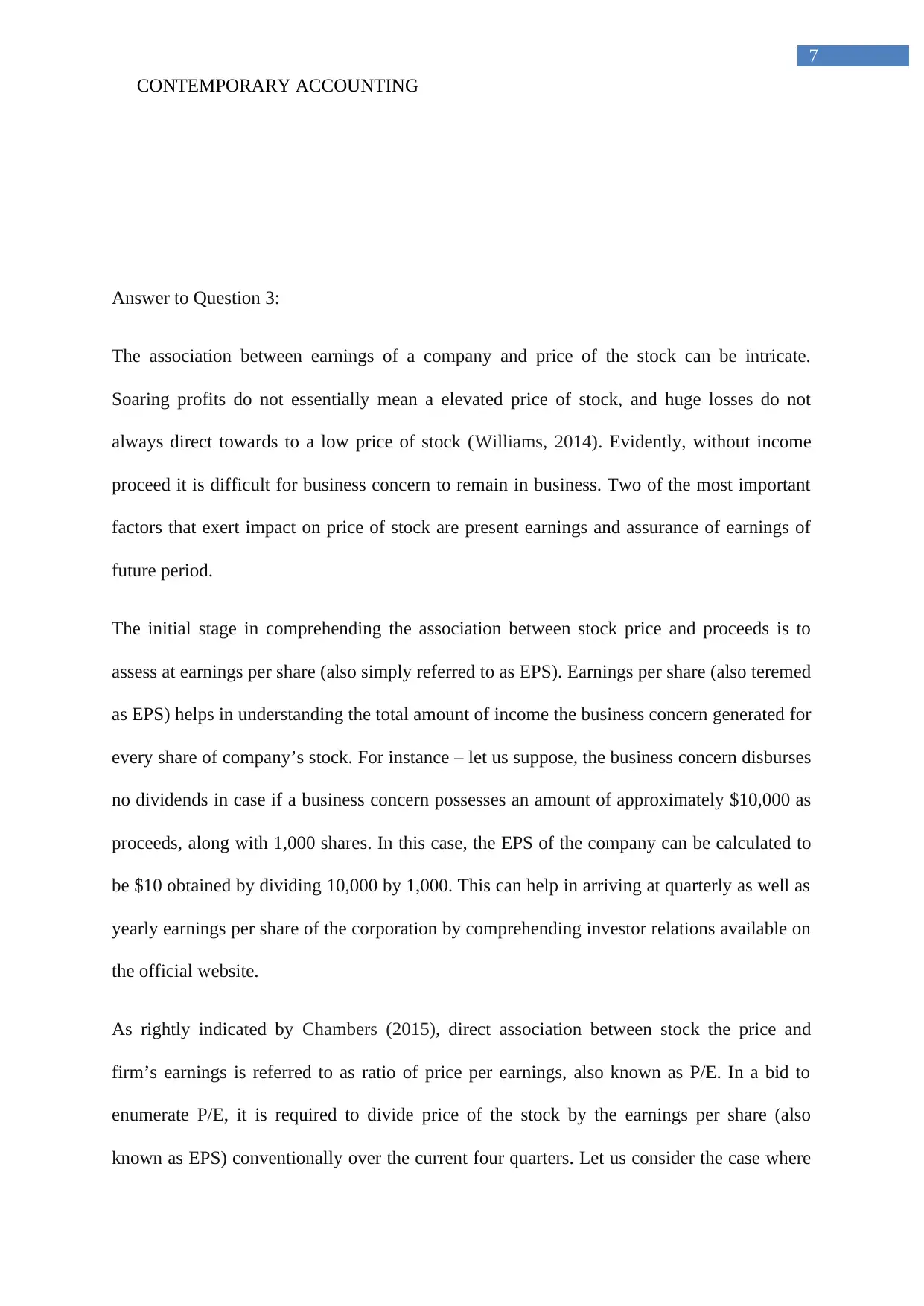
7
CONTEMPORARY ACCOUNTING
Answer to Question 3:
The association between earnings of a company and price of the stock can be intricate.
Soaring profits do not essentially mean a elevated price of stock, and huge losses do not
always direct towards to a low price of stock (Williams, 2014). Evidently, without income
proceed it is difficult for business concern to remain in business. Two of the most important
factors that exert impact on price of stock are present earnings and assurance of earnings of
future period.
The initial stage in comprehending the association between stock price and proceeds is to
assess at earnings per share (also simply referred to as EPS). Earnings per share (also teremed
as EPS) helps in understanding the total amount of income the business concern generated for
every share of company’s stock. For instance – let us suppose, the business concern disburses
no dividends in case if a business concern possesses an amount of approximately $10,000 as
proceeds, along with 1,000 shares. In this case, the EPS of the company can be calculated to
be $10 obtained by dividing 10,000 by 1,000. This can help in arriving at quarterly as well as
yearly earnings per share of the corporation by comprehending investor relations available on
the official website.
As rightly indicated by Chambers (2015), direct association between stock the price and
firm’s earnings is referred to as ratio of price per earnings, also known as P/E. In a bid to
enumerate P/E, it is required to divide price of the stock by the earnings per share (also
known as EPS) conventionally over the current four quarters. Let us consider the case where
CONTEMPORARY ACCOUNTING
Answer to Question 3:
The association between earnings of a company and price of the stock can be intricate.
Soaring profits do not essentially mean a elevated price of stock, and huge losses do not
always direct towards to a low price of stock (Williams, 2014). Evidently, without income
proceed it is difficult for business concern to remain in business. Two of the most important
factors that exert impact on price of stock are present earnings and assurance of earnings of
future period.
The initial stage in comprehending the association between stock price and proceeds is to
assess at earnings per share (also simply referred to as EPS). Earnings per share (also teremed
as EPS) helps in understanding the total amount of income the business concern generated for
every share of company’s stock. For instance – let us suppose, the business concern disburses
no dividends in case if a business concern possesses an amount of approximately $10,000 as
proceeds, along with 1,000 shares. In this case, the EPS of the company can be calculated to
be $10 obtained by dividing 10,000 by 1,000. This can help in arriving at quarterly as well as
yearly earnings per share of the corporation by comprehending investor relations available on
the official website.
As rightly indicated by Chambers (2015), direct association between stock the price and
firm’s earnings is referred to as ratio of price per earnings, also known as P/E. In a bid to
enumerate P/E, it is required to divide price of the stock by the earnings per share (also
known as EPS) conventionally over the current four quarters. Let us consider the case where
Paraphrase This Document
Need a fresh take? Get an instant paraphrase of this document with our AI Paraphraser
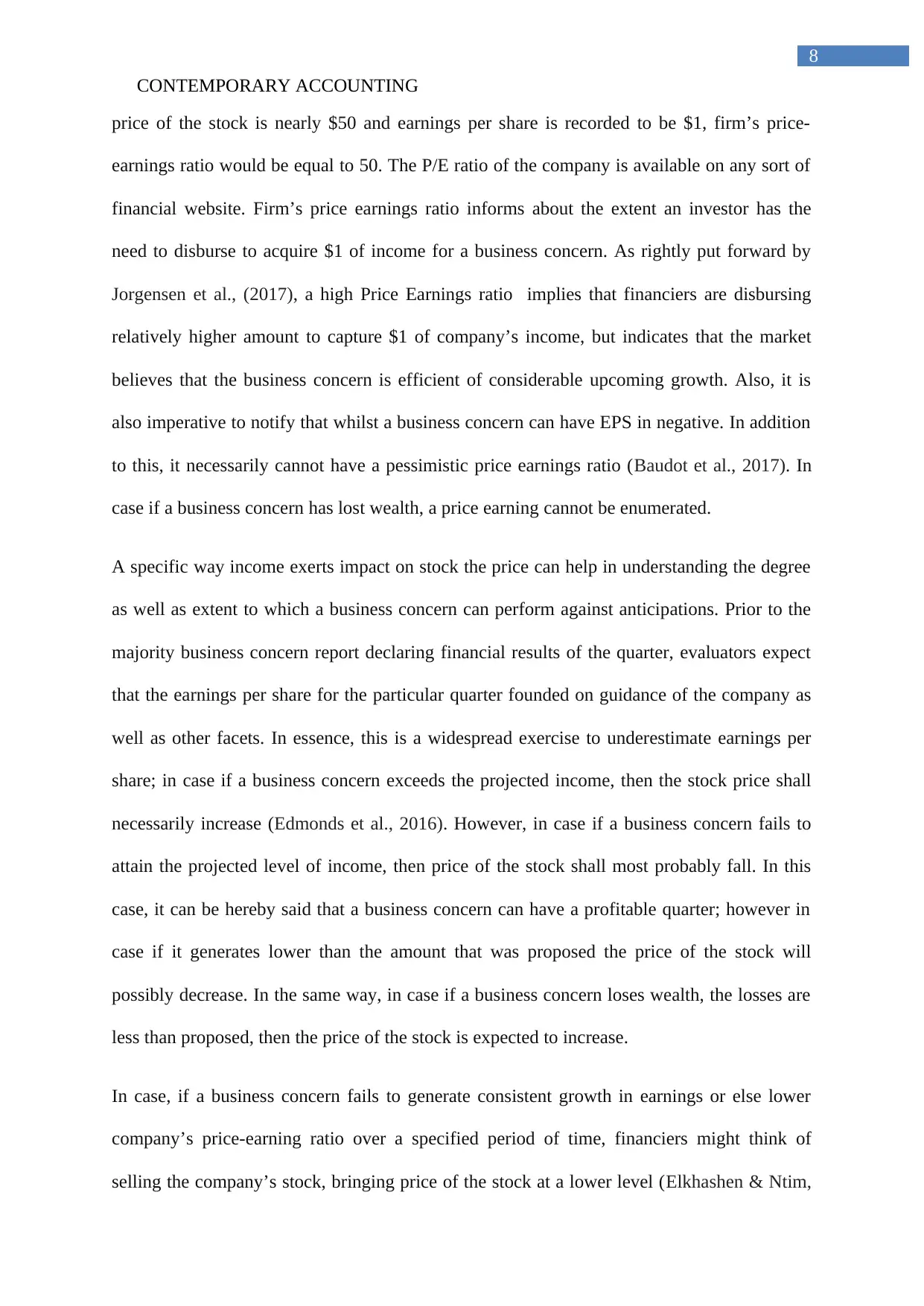
8
CONTEMPORARY ACCOUNTING
price of the stock is nearly $50 and earnings per share is recorded to be $1, firm’s price-
earnings ratio would be equal to 50. The P/E ratio of the company is available on any sort of
financial website. Firm’s price earnings ratio informs about the extent an investor has the
need to disburse to acquire $1 of income for a business concern. As rightly put forward by
Jorgensen et al., (2017), a high Price Earnings ratio implies that financiers are disbursing
relatively higher amount to capture $1 of company’s income, but indicates that the market
believes that the business concern is efficient of considerable upcoming growth. Also, it is
also imperative to notify that whilst a business concern can have EPS in negative. In addition
to this, it necessarily cannot have a pessimistic price earnings ratio (Baudot et al., 2017). In
case if a business concern has lost wealth, a price earning cannot be enumerated.
A specific way income exerts impact on stock the price can help in understanding the degree
as well as extent to which a business concern can perform against anticipations. Prior to the
majority business concern report declaring financial results of the quarter, evaluators expect
that the earnings per share for the particular quarter founded on guidance of the company as
well as other facets. In essence, this is a widespread exercise to underestimate earnings per
share; in case if a business concern exceeds the projected income, then the stock price shall
necessarily increase (Edmonds et al., 2016). However, in case if a business concern fails to
attain the projected level of income, then price of the stock shall most probably fall. In this
case, it can be hereby said that a business concern can have a profitable quarter; however in
case if it generates lower than the amount that was proposed the price of the stock will
possibly decrease. In the same way, in case if a business concern loses wealth, the losses are
less than proposed, then the price of the stock is expected to increase.
In case, if a business concern fails to generate consistent growth in earnings or else lower
company’s price-earning ratio over a specified period of time, financiers might think of
selling the company’s stock, bringing price of the stock at a lower level (Elkhashen & Ntim,
CONTEMPORARY ACCOUNTING
price of the stock is nearly $50 and earnings per share is recorded to be $1, firm’s price-
earnings ratio would be equal to 50. The P/E ratio of the company is available on any sort of
financial website. Firm’s price earnings ratio informs about the extent an investor has the
need to disburse to acquire $1 of income for a business concern. As rightly put forward by
Jorgensen et al., (2017), a high Price Earnings ratio implies that financiers are disbursing
relatively higher amount to capture $1 of company’s income, but indicates that the market
believes that the business concern is efficient of considerable upcoming growth. Also, it is
also imperative to notify that whilst a business concern can have EPS in negative. In addition
to this, it necessarily cannot have a pessimistic price earnings ratio (Baudot et al., 2017). In
case if a business concern has lost wealth, a price earning cannot be enumerated.
A specific way income exerts impact on stock the price can help in understanding the degree
as well as extent to which a business concern can perform against anticipations. Prior to the
majority business concern report declaring financial results of the quarter, evaluators expect
that the earnings per share for the particular quarter founded on guidance of the company as
well as other facets. In essence, this is a widespread exercise to underestimate earnings per
share; in case if a business concern exceeds the projected income, then the stock price shall
necessarily increase (Edmonds et al., 2016). However, in case if a business concern fails to
attain the projected level of income, then price of the stock shall most probably fall. In this
case, it can be hereby said that a business concern can have a profitable quarter; however in
case if it generates lower than the amount that was proposed the price of the stock will
possibly decrease. In the same way, in case if a business concern loses wealth, the losses are
less than proposed, then the price of the stock is expected to increase.
In case, if a business concern fails to generate consistent growth in earnings or else lower
company’s price-earning ratio over a specified period of time, financiers might think of
selling the company’s stock, bringing price of the stock at a lower level (Elkhashen & Ntim,
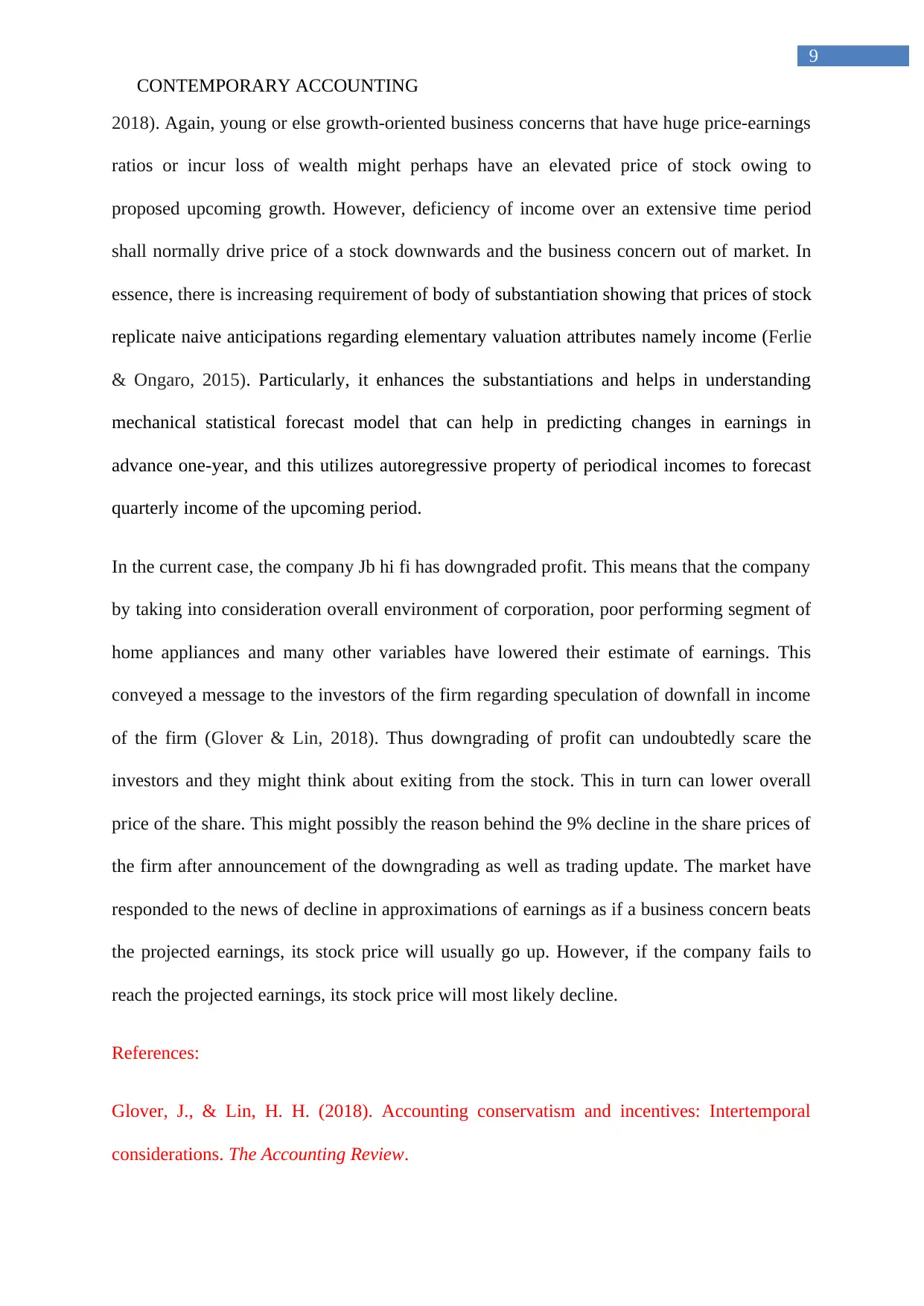
9
CONTEMPORARY ACCOUNTING
2018). Again, young or else growth-oriented business concerns that have huge price-earnings
ratios or incur loss of wealth might perhaps have an elevated price of stock owing to
proposed upcoming growth. However, deficiency of income over an extensive time period
shall normally drive price of a stock downwards and the business concern out of market. In
essence, there is increasing requirement of body of substantiation showing that prices of stock
replicate naive anticipations regarding elementary valuation attributes namely income (Ferlie
& Ongaro, 2015). Particularly, it enhances the substantiations and helps in understanding
mechanical statistical forecast model that can help in predicting changes in earnings in
advance one-year, and this utilizes autoregressive property of periodical incomes to forecast
quarterly income of the upcoming period.
In the current case, the company Jb hi fi has downgraded profit. This means that the company
by taking into consideration overall environment of corporation, poor performing segment of
home appliances and many other variables have lowered their estimate of earnings. This
conveyed a message to the investors of the firm regarding speculation of downfall in income
of the firm (Glover & Lin, 2018). Thus downgrading of profit can undoubtedly scare the
investors and they might think about exiting from the stock. This in turn can lower overall
price of the share. This might possibly the reason behind the 9% decline in the share prices of
the firm after announcement of the downgrading as well as trading update. The market have
responded to the news of decline in approximations of earnings as if a business concern beats
the projected earnings, its stock price will usually go up. However, if the company fails to
reach the projected earnings, its stock price will most likely decline.
References:
Glover, J., & Lin, H. H. (2018). Accounting conservatism and incentives: Intertemporal
considerations. The Accounting Review.
CONTEMPORARY ACCOUNTING
2018). Again, young or else growth-oriented business concerns that have huge price-earnings
ratios or incur loss of wealth might perhaps have an elevated price of stock owing to
proposed upcoming growth. However, deficiency of income over an extensive time period
shall normally drive price of a stock downwards and the business concern out of market. In
essence, there is increasing requirement of body of substantiation showing that prices of stock
replicate naive anticipations regarding elementary valuation attributes namely income (Ferlie
& Ongaro, 2015). Particularly, it enhances the substantiations and helps in understanding
mechanical statistical forecast model that can help in predicting changes in earnings in
advance one-year, and this utilizes autoregressive property of periodical incomes to forecast
quarterly income of the upcoming period.
In the current case, the company Jb hi fi has downgraded profit. This means that the company
by taking into consideration overall environment of corporation, poor performing segment of
home appliances and many other variables have lowered their estimate of earnings. This
conveyed a message to the investors of the firm regarding speculation of downfall in income
of the firm (Glover & Lin, 2018). Thus downgrading of profit can undoubtedly scare the
investors and they might think about exiting from the stock. This in turn can lower overall
price of the share. This might possibly the reason behind the 9% decline in the share prices of
the firm after announcement of the downgrading as well as trading update. The market have
responded to the news of decline in approximations of earnings as if a business concern beats
the projected earnings, its stock price will usually go up. However, if the company fails to
reach the projected earnings, its stock price will most likely decline.
References:
Glover, J., & Lin, H. H. (2018). Accounting conservatism and incentives: Intertemporal
considerations. The Accounting Review.
⊘ This is a preview!⊘
Do you want full access?
Subscribe today to unlock all pages.

Trusted by 1+ million students worldwide
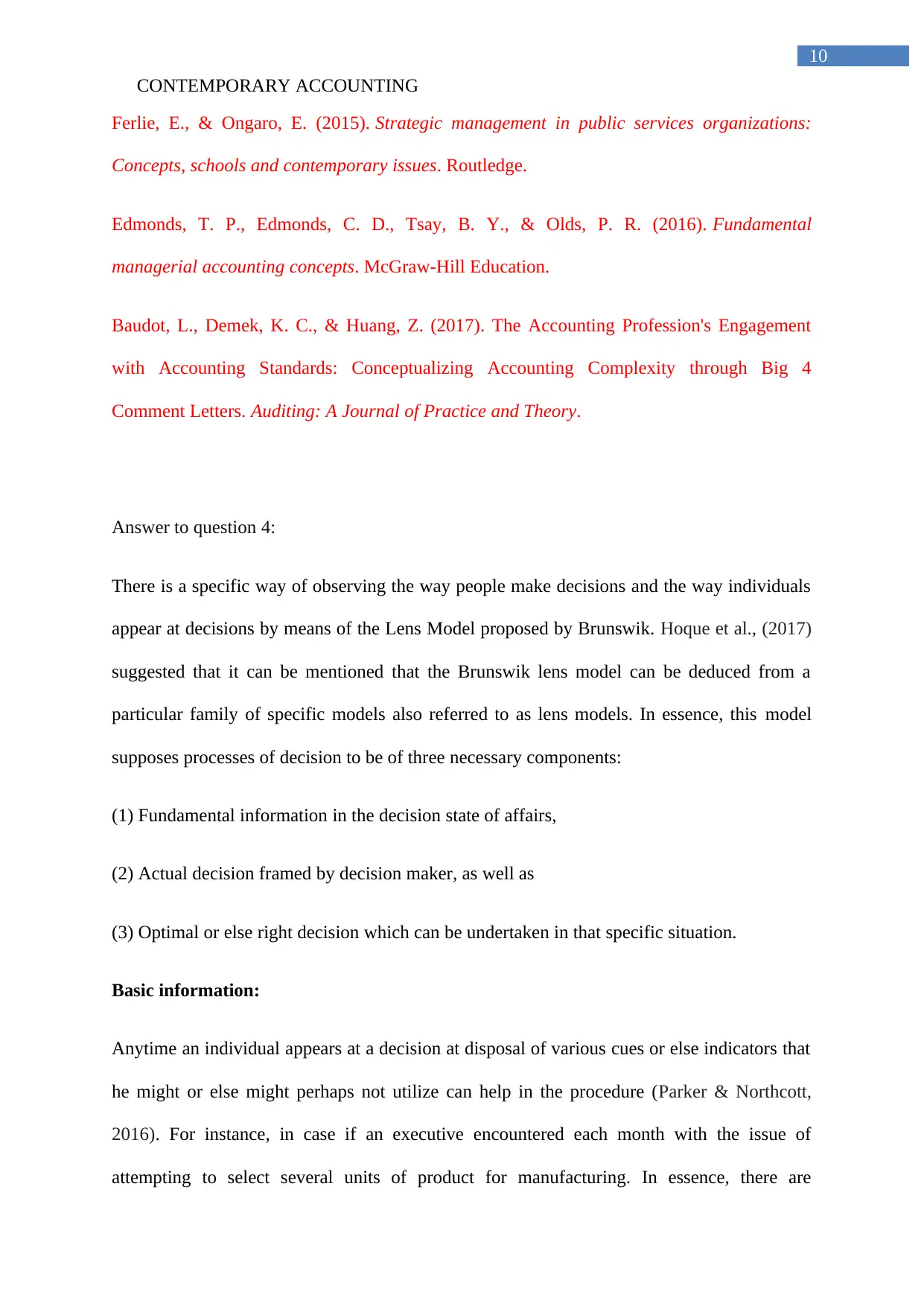
10
CONTEMPORARY ACCOUNTING
Ferlie, E., & Ongaro, E. (2015). Strategic management in public services organizations:
Concepts, schools and contemporary issues. Routledge.
Edmonds, T. P., Edmonds, C. D., Tsay, B. Y., & Olds, P. R. (2016). Fundamental
managerial accounting concepts. McGraw-Hill Education.
Baudot, L., Demek, K. C., & Huang, Z. (2017). The Accounting Profession's Engagement
with Accounting Standards: Conceptualizing Accounting Complexity through Big 4
Comment Letters. Auditing: A Journal of Practice and Theory.
Answer to question 4:
There is a specific way of observing the way people make decisions and the way individuals
appear at decisions by means of the Lens Model proposed by Brunswik. Hoque et al., (2017)
suggested that it can be mentioned that the Brunswik lens model can be deduced from a
particular family of specific models also referred to as lens models. In essence, this model
supposes processes of decision to be of three necessary components:
(1) Fundamental information in the decision state of affairs,
(2) Actual decision framed by decision maker, as well as
(3) Optimal or else right decision which can be undertaken in that specific situation.
Basic information:
Anytime an individual appears at a decision at disposal of various cues or else indicators that
he might or else might perhaps not utilize can help in the procedure (Parker & Northcott,
2016). For instance, in case if an executive encountered each month with the issue of
attempting to select several units of product for manufacturing. In essence, there are
CONTEMPORARY ACCOUNTING
Ferlie, E., & Ongaro, E. (2015). Strategic management in public services organizations:
Concepts, schools and contemporary issues. Routledge.
Edmonds, T. P., Edmonds, C. D., Tsay, B. Y., & Olds, P. R. (2016). Fundamental
managerial accounting concepts. McGraw-Hill Education.
Baudot, L., Demek, K. C., & Huang, Z. (2017). The Accounting Profession's Engagement
with Accounting Standards: Conceptualizing Accounting Complexity through Big 4
Comment Letters. Auditing: A Journal of Practice and Theory.
Answer to question 4:
There is a specific way of observing the way people make decisions and the way individuals
appear at decisions by means of the Lens Model proposed by Brunswik. Hoque et al., (2017)
suggested that it can be mentioned that the Brunswik lens model can be deduced from a
particular family of specific models also referred to as lens models. In essence, this model
supposes processes of decision to be of three necessary components:
(1) Fundamental information in the decision state of affairs,
(2) Actual decision framed by decision maker, as well as
(3) Optimal or else right decision which can be undertaken in that specific situation.
Basic information:
Anytime an individual appears at a decision at disposal of various cues or else indicators that
he might or else might perhaps not utilize can help in the procedure (Parker & Northcott,
2016). For instance, in case if an executive encountered each month with the issue of
attempting to select several units of product for manufacturing. In essence, there are
Paraphrase This Document
Need a fresh take? Get an instant paraphrase of this document with our AI Paraphraser
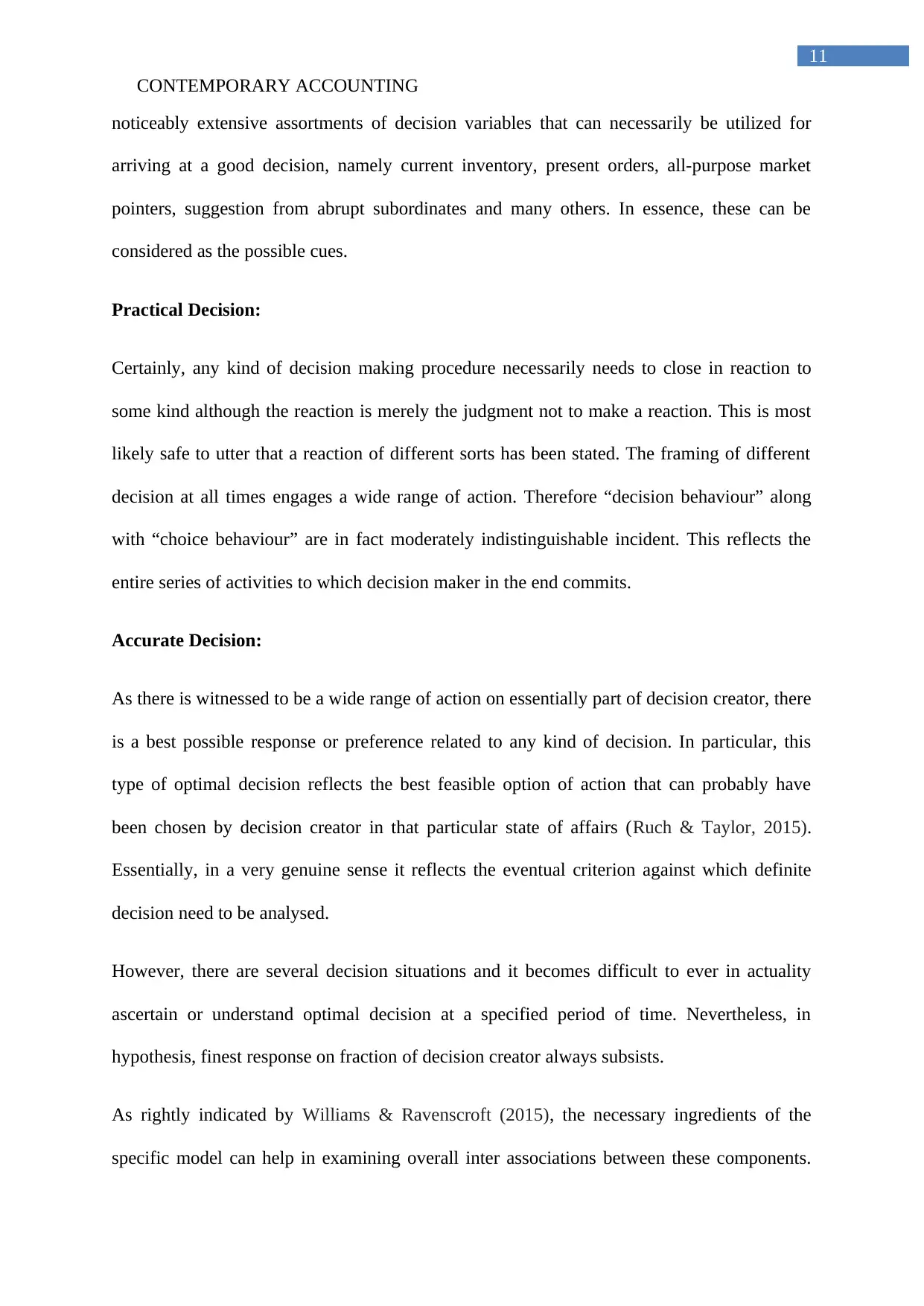
11
CONTEMPORARY ACCOUNTING
noticeably extensive assortments of decision variables that can necessarily be utilized for
arriving at a good decision, namely current inventory, present orders, all-purpose market
pointers, suggestion from abrupt subordinates and many others. In essence, these can be
considered as the possible cues.
Practical Decision:
Certainly, any kind of decision making procedure necessarily needs to close in reaction to
some kind although the reaction is merely the judgment not to make a reaction. This is most
likely safe to utter that a reaction of different sorts has been stated. The framing of different
decision at all times engages a wide range of action. Therefore “decision behaviour” along
with “choice behaviour” are in fact moderately indistinguishable incident. This reflects the
entire series of activities to which decision maker in the end commits.
Accurate Decision:
As there is witnessed to be a wide range of action on essentially part of decision creator, there
is a best possible response or preference related to any kind of decision. In particular, this
type of optimal decision reflects the best feasible option of action that can probably have
been chosen by decision creator in that particular state of affairs (Ruch & Taylor, 2015).
Essentially, in a very genuine sense it reflects the eventual criterion against which definite
decision need to be analysed.
However, there are several decision situations and it becomes difficult to ever in actuality
ascertain or understand optimal decision at a specified period of time. Nevertheless, in
hypothesis, finest response on fraction of decision creator always subsists.
As rightly indicated by Williams & Ravenscroft (2015), the necessary ingredients of the
specific model can help in examining overall inter associations between these components.
CONTEMPORARY ACCOUNTING
noticeably extensive assortments of decision variables that can necessarily be utilized for
arriving at a good decision, namely current inventory, present orders, all-purpose market
pointers, suggestion from abrupt subordinates and many others. In essence, these can be
considered as the possible cues.
Practical Decision:
Certainly, any kind of decision making procedure necessarily needs to close in reaction to
some kind although the reaction is merely the judgment not to make a reaction. This is most
likely safe to utter that a reaction of different sorts has been stated. The framing of different
decision at all times engages a wide range of action. Therefore “decision behaviour” along
with “choice behaviour” are in fact moderately indistinguishable incident. This reflects the
entire series of activities to which decision maker in the end commits.
Accurate Decision:
As there is witnessed to be a wide range of action on essentially part of decision creator, there
is a best possible response or preference related to any kind of decision. In particular, this
type of optimal decision reflects the best feasible option of action that can probably have
been chosen by decision creator in that particular state of affairs (Ruch & Taylor, 2015).
Essentially, in a very genuine sense it reflects the eventual criterion against which definite
decision need to be analysed.
However, there are several decision situations and it becomes difficult to ever in actuality
ascertain or understand optimal decision at a specified period of time. Nevertheless, in
hypothesis, finest response on fraction of decision creator always subsists.
As rightly indicated by Williams & Ravenscroft (2015), the necessary ingredients of the
specific model can help in examining overall inter associations between these components.
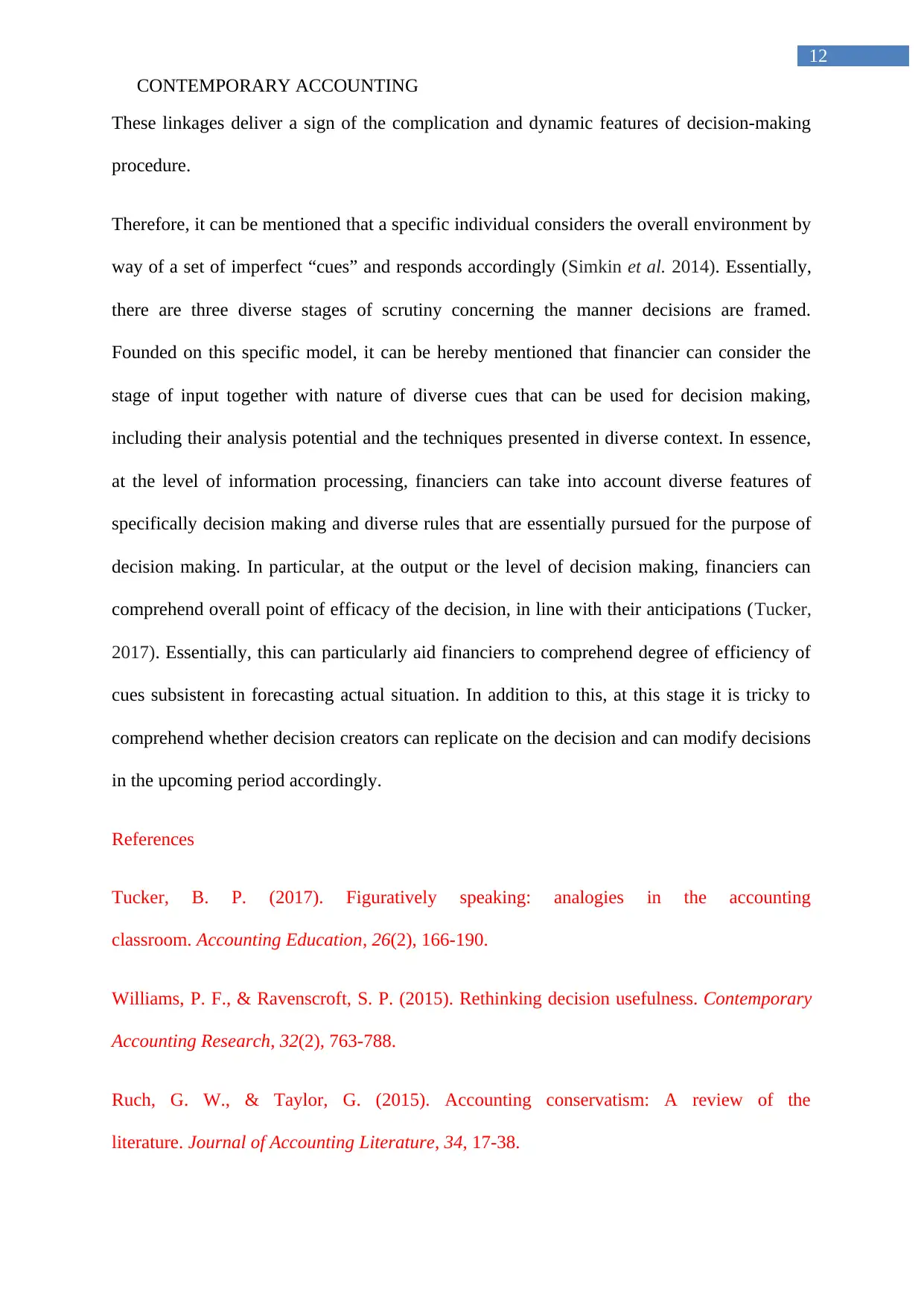
12
CONTEMPORARY ACCOUNTING
These linkages deliver a sign of the complication and dynamic features of decision-making
procedure.
Therefore, it can be mentioned that a specific individual considers the overall environment by
way of a set of imperfect “cues” and responds accordingly (Simkin et al. 2014). Essentially,
there are three diverse stages of scrutiny concerning the manner decisions are framed.
Founded on this specific model, it can be hereby mentioned that financier can consider the
stage of input together with nature of diverse cues that can be used for decision making,
including their analysis potential and the techniques presented in diverse context. In essence,
at the level of information processing, financiers can take into account diverse features of
specifically decision making and diverse rules that are essentially pursued for the purpose of
decision making. In particular, at the output or the level of decision making, financiers can
comprehend overall point of efficacy of the decision, in line with their anticipations (Tucker,
2017). Essentially, this can particularly aid financiers to comprehend degree of efficiency of
cues subsistent in forecasting actual situation. In addition to this, at this stage it is tricky to
comprehend whether decision creators can replicate on the decision and can modify decisions
in the upcoming period accordingly.
References
Tucker, B. P. (2017). Figuratively speaking: analogies in the accounting
classroom. Accounting Education, 26(2), 166-190.
Williams, P. F., & Ravenscroft, S. P. (2015). Rethinking decision usefulness. Contemporary
Accounting Research, 32(2), 763-788.
Ruch, G. W., & Taylor, G. (2015). Accounting conservatism: A review of the
literature. Journal of Accounting Literature, 34, 17-38.
CONTEMPORARY ACCOUNTING
These linkages deliver a sign of the complication and dynamic features of decision-making
procedure.
Therefore, it can be mentioned that a specific individual considers the overall environment by
way of a set of imperfect “cues” and responds accordingly (Simkin et al. 2014). Essentially,
there are three diverse stages of scrutiny concerning the manner decisions are framed.
Founded on this specific model, it can be hereby mentioned that financier can consider the
stage of input together with nature of diverse cues that can be used for decision making,
including their analysis potential and the techniques presented in diverse context. In essence,
at the level of information processing, financiers can take into account diverse features of
specifically decision making and diverse rules that are essentially pursued for the purpose of
decision making. In particular, at the output or the level of decision making, financiers can
comprehend overall point of efficacy of the decision, in line with their anticipations (Tucker,
2017). Essentially, this can particularly aid financiers to comprehend degree of efficiency of
cues subsistent in forecasting actual situation. In addition to this, at this stage it is tricky to
comprehend whether decision creators can replicate on the decision and can modify decisions
in the upcoming period accordingly.
References
Tucker, B. P. (2017). Figuratively speaking: analogies in the accounting
classroom. Accounting Education, 26(2), 166-190.
Williams, P. F., & Ravenscroft, S. P. (2015). Rethinking decision usefulness. Contemporary
Accounting Research, 32(2), 763-788.
Ruch, G. W., & Taylor, G. (2015). Accounting conservatism: A review of the
literature. Journal of Accounting Literature, 34, 17-38.
⊘ This is a preview!⊘
Do you want full access?
Subscribe today to unlock all pages.

Trusted by 1+ million students worldwide
1 out of 14
Related Documents
Your All-in-One AI-Powered Toolkit for Academic Success.
+13062052269
info@desklib.com
Available 24*7 on WhatsApp / Email
![[object Object]](/_next/static/media/star-bottom.7253800d.svg)
Unlock your academic potential
Copyright © 2020–2025 A2Z Services. All Rights Reserved. Developed and managed by ZUCOL.





